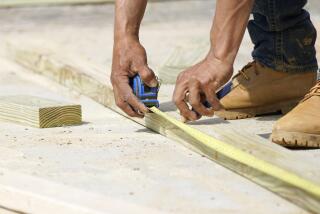Remodeling Project Means Lots of Work
- Share via
Question: I’m planning a major remodel. It will include two rooms, totaling 1,000 square feet. I’m not a contractor but I’m going to act as my own general and subcontract the work. Could you list the trades people needed and tell me which parts of the job need permits and which don’t? Last, at what points should I have the job inspected to make sure the improvements comply with the building code?
Answer: You are brave embark on a home remodel. This comment is not meant to discourage but merely to warn you of the financial and emotional intensity of this type of project. Be sure to do as much research as possible before commencing. And expect that your costs will inevitably exceed the most careful projections and estimates.
Prepare a detailed conceptual plan of the work. As building construction is not part of your previous experience, you should consult a licensed architect. The first meeting should take place at the house and include a complete explanation of your ideas and objectives.
The architect can then prepare a comprehensive drawing of the proposed changes to the building, including dimensions and specifications. For an extra fee, a complete list of building materials can be provided, enabling you to determine the approximate costs of supplies for the job.
Present the plans to your local building department for a review to determine if the proposed work complies with required setbacks from the property lines and if the plan is in accord with applicable building codes and structural engineering standards.
Once the plans are approved (a process that can take days or months, depending upon the administrative inclinations of your friendly bureaucracy), you will pay a permit fee and be ready to begin construction.
A building permit generally applies to the total project. You should not have to obtain separate permits for various components.
Areas often omitted from the permit process, however, may include fencing, landscaping and paving. But this can vary from one municipality to another, depending upon the desire of local authorities to control and tax their constituencies.
The subcontractors and trades people you need to hire will include, but are by no means limited to, the following:
* A grading contractor for site preparation, including necessary leveling of the grounds, provisions for surface drainage and excavation for foundations.
* Carpenters or a contractor to set up foundation forms and install the reinforcing steel.
* Plumbing, electrical and heating contractors to make preparatory installations before the foundation is poured and to coordinate mechanical work and installations with the various other trades.
* A concrete supplier and finisher for pouring of the foundation.
* Framers to erect the structure.
* Drywall installers and finishers to surface the interior walls and ceilings.
* Carpenters and/or plasterers to provide finished surfaces for the exterior.
* A roofing contractor to install an adequate water shed.
* Numerous other technicians, craftsmen and contractors, including floor installer, painter, cabinetmaker, counter top installer, appliance installer, paving contractor, fireplace contractor and landscaper.
As to inspections, your building department will inform you of the sequence. At the outset of the project, you will be given an inspection card to be posted on the site. This will list a series of inspections to take place as the job progresses.
The first of these is the foundation inspection, to be performed before concrete is poured. This enables the inspector to ensure that the trenches are excavated to the proper dimensions, that the forms are properly laid out and that the steel rebar is correctly installed.
Next comes the framing inspection, when the wood structure is in place and all of the rough plumbing and electrical work has been completed. At this point the inspector can determine that all portions of the construction are correctly done before they are concealed behind the drywall and other finish materials.
Upon completion of each sign-off, the inspector will let you know the next stage of construction that requires further inspection. You simply complete that amount of work and call the building department for the next review. The last of these, commonly known as “the final,” is the time at which the building department approves the house for occupancy.
By the time you occupy your renovated home, you’ll probably wonder if it was worth the energy and effort. People often say they would not have begun had they known the demanding extent of the total project.
On the other hand, the benefits and enjoyment of your improved residence will far outlast your memory of discomforts endured for the cause.
*
For more information, visit Remodeling Online, at https://www.remodeling.hw.net and Harvard University’s Home Building and Remodeling Network at https://www.hbrnet.com.
If you have questions or comments, contact Barry Stone through his Web site at https://www.housedetective.com.
*
Distributed by Access Media Group.
More to Read
Sign up for Essential California
The most important California stories and recommendations in your inbox every morning.
You may occasionally receive promotional content from the Los Angeles Times.






